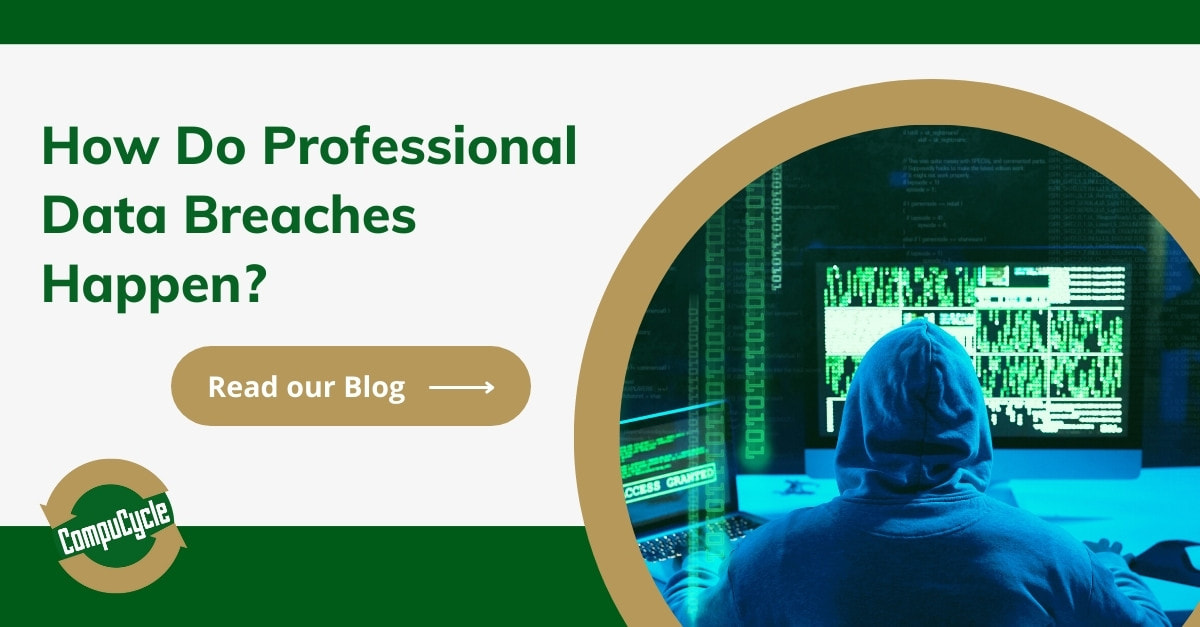
Data breaches increased by 50% in 2021, with education/research and healthcare being the most targeted at +75% and +71%, respectively. Unfortunately, that is a reality we must become accustomed to in a highly digitized world. Cyberattacks have been a regular nuisance since the initial days and have only increased. Unfortunately, the lack of secure data destruction only adds to this concern.

People take several measures to protect against data breaches depending on the data type. For example, organizations typically leverage cybersecurity software to protect archived and existing data. They also use secure passwords and controlled access to minimize risk. However, that’s not all. You will also need to work with certified data destruction companies for equipment disposal.
This blog will mention some key data breach statistics before listing the top reasons data breaches happen.
Data Breach Statistics
Cybersecurity has become a need for organizations, given the losses it causes. The problem is that it is an evolving field, so even tech giants are often vulnerable, let alone small and medium businesses with limited resources for protection. The following statistics will give you a better idea of
- Data breaches cost an average of $4.24 million annually, while ransomware costs $4.64 million.
- Yahoo lost details of 3 billion users in the August 2013 data breach.
- Organizations lost $1.59 million in lost business opportunities due to data breaches in 2021.
- 53% of healthcare data breaches result from negligence or malicious insiders.
- More than 100,000 people at HealthReach Community Health Centers lost their data due to a lack of secure data destruction before disposal.
- 43% of all cyberattacks target small businesses, but only 14% are prepared to defend themselves.
- Ransomware grew by 21% between 2017 and 2018, followed by malicious insider data breaches at 15%.
- Phishing is responsible for 57% of the attacks on small businesses.
- These statistics prove that data breaches and cyberattacks carry a significant financial burden. The cost also includes the money the business has to spend rebuilding its reputation to reinstate consumer trust in its ability to protect their information.
How do Professional Data Breaches Happen?
Knowing how to protect against data breaches is only possible if you understand how they happen. Following are the top sources of cyber risk that leave a business vulnerable:
1. Outdated Security
Most operating software receives regular updates to cover any inadequacies, inefficiencies, or security risks. Failing to keep your software up-to-date can put the organization at risk of a cyberattack because hackers can capitalize on the vulnerabilities.
Hence, it is best to protect against such mishaps by assigning your IT department the responsibility to check and ensure that all systems are running the latest patches. This rule also applies to other applications that involve data handling.
2. Phishing
Phishing is using fraudulent communication. Usually, emails or similar messages to get the person to reveal sensitive information. It is one of the most common cyberattacks, and the recent attempts have become increasingly deceptive. An estimated 3.4 billion fraudulent emails are sent daily, and several of these target organization employees to attempt data breaches. Hence, training people to increase awareness about such emails and reduce cybersecurity risk is best.
3. Malicious Insiders
Malicious insiders are employees who operate against their organization and steal crucial data for personal gains. They use this data for ransom, sell it, or disrupt the organization’s operations. As mentioned above, this form of a data breach has been rising in the past few years and is responsible for a significant percentage of losses.
4. Human Error
Mistakes are a routine part of life, and there is no avoiding a minor issue here and there. However, despite the lack of malicious intent, some of these errors can put the company at severe risk. For example, an auditor leaving their system logged in while they go to grab a cup of coffee or an IT team member accidentally forgetting to restrict access for a disgruntled former employee.
These errors can cause data leaks and become a significant cause for concern.
5. Negligent Disposal
Secure data destruction is critical in cybersecurity, especially since few organizations know how to wipe data before discarding an electronic. The best solution is to hire data destruction companies to ensure your information is secure and inaccessible to others.
6. Stolen Credentials
Lastly, stolen credentials are another source of cyberattack and have become increasingly common as the world becomes more digitized. They are why applications like Google and Facebook have set up 2-Factor Authentication and keep working on ways to reduce risk.
Wrapping Up
Professional data breaches are a significant financial burden, and you must deploy suitable solutions to manage them. Secure data destruction, cybersecurity, and similar methods are critical for protecting your organization against cybercriminals and minimizing risk.
Recent Articles
Secure Electronics Disposal in Houston: Why the City’s Largest Industries Trust CompuCycle
When a major healthcare system decommissions thousands of laptops, or an oil and gas company retires an entire data center, one question comes up again and again: What happens to all that data — and…
Read MoreCompuCycle Executives Join R2 TAC and e-Stewards Leadership Council to Advance ITAD Standards
Houston-based ITAD provider deepens its industry influence through active participation in standard-setting committees. As corporate ITAD needs evolve alongside stricter compliance and ESG requirements, CompuCycle continues to lead the way—this time by contributing directly to…
Read MoreI’m Just a Computer: A Journey Through ITAD Recycling
Meet Chip the Computer – he’s about to take you on an unforgettable journey through the world of IT Asset Disposition (ITAD). Buckle up for an adventure that’s both educational and entertaining! Chapter 1: “Hello,…
Read MoreIs There a Wrong Way to Recycle Electronics?
Most people agree that recycling electronics is the right thing to do. It prevents hazardous waste from entering landfills, supports sustainability goals, and allows for the recovery of valuable materials. But what many businesses don’t…
Read More


